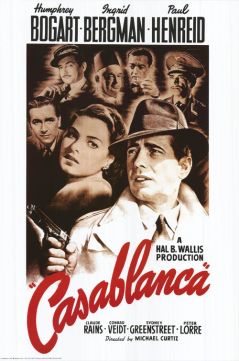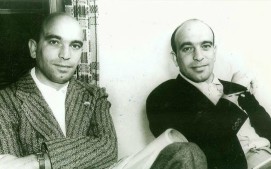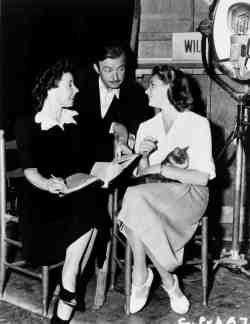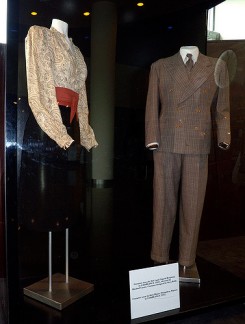
Welcome back, Ms. Bergman!

What hasn’t been said about Casablanca? What hasn’t been asked about Casablanca? This is a film that’s been parsed, analyzed, memorialized, quoted, parodied, and collected more homage than most films in history, with the exception of Citizen Kane and The Wizard of Oz, of course. What’s left to be said?
Plenty. It’s a classic film that we buffs like to revisit. Bogie. Bergman.
“Play it, Sam.”
“I am shocked! Shocked!”
“Louis, I think this is the beginning of a beautiful friendship.”
Dreamy sigh.

What many people may not know, however, is that Bergman wasn’t the first choice for the part of Ilsa. Hal Wallis and casting director Steve Tilling initially thought of Hedy Lamarr, but Louis B. Mayer refused to loan her out. Then there was talk of casting Ann Sheridan or Mary Astor, which went nowhere. It’s a good thing, too, because Sheridan would have been too hard-boiled and Astor too deadpan. Michéle Morgan was a top contender for a while, but what initial buzz there was about her fizzled out, because Wallis had other plans.
Ingrid Bergman was under contract to David O. Selznik at the time and new to American audiences, who had loved her in Intermezzo. Understandably, Selznik was reluctant to loan Bergman out, so in a stroke of excellent judgement, Wallis conscripted the Epstein brothers, Julius and Phillip, to have lunch with Selznik and talk him into it.

Well, it wasn’t exactly lunch. Selznik sat at his desk eating a bowl of soup while the Epsteins pitched the movie to him, but it wasn’t until Julius Epstein compared the project to MGM’s recent hit, Algiers that David O. reacted. He, like a typical Hollywood executive, relished having copious amounts of money waved in his face, or at least the prospect of copious amounts of money. $125,000 and the loan of Olivia de Havilland sweetened the deal.
Selznik was happy, but Ingrid Bergman was nervous. Casablanca’s script wasn’t finished yet, and she had no idea what she was going to have to do in the course of the film. Based on a play called “Everyone Comes To Rick’s,” the Casablanca script was never really finalized, giving it an off-the-cuff quality. Working with Bogart unnerved Bergman as well, and she watched The Maltese Falcon over and over again to get used to Bogart’s mannerisms and to make him seem less scary.

When the script was basically done, it only added to Bergman’s apprehension, because she thought it was too fluffy. She also had her sights set on a role in For Whom the Bell Tolls, which she thought would do more for her career. However, she did have a commonality with the Casablanca story. In 1940, when she and her daughter, Pia came to America, their cruise ship had to make an unscheduled stop in Lisbon, where they picked up some refugees. Like those portrayed in the film, there were people among them who had come to Lisbon via Casablanca.
There was one thing Bergman had very definite ideas about, and that was her look. Selznik wanted her to have the standard glamour treatment–plucked eyebrows, tons of makeup, the works, but Ingrid would have none of it. She fought so hard that she got Selznik on her side and he told his studio makeup artist that he wasn’t allowed to change anything. Bergman’s naturalness carried over into her character of Ilsa, whose simple dress highlighted who she was: A woman for whom the line between love and duty is very, very blurry.

Bergman’s Maltese Falcon viewings may have been unnecessary. It’s tough to find someone intimidating when they’re an inch shorter. Bogart wore lifts in his shoes to make his five-feet-eight-inches look like six feet, sat on pillows at tables, and was never shown in anything but forced perspective. Even so, five-foot-nine Bergman in her heels was always taller. Maybe she could have worn flats, like Ann Miller always did when she worked with Fred Astaire, but a proper European woman may have found it unsuitable.
It’s also hard to find someone intimidating when they’re not around. Bogart’s wife at the time, Mayo Methot was insanely jealous of his leading ladies, or any women who were within striking distance of her husband. She would hang around the set making everyone miserable and going at Bogart whenever she could. Naturally, she accused Bogie and Bergman of having an affair, which was absurd, because they didn’t talk. Bogart would appear in time for director Michael Curtiz to yell, “Action!” but as soon as he heard “Cut!” he was off again. The much-beleagured Bogart would hole up in his trailer, either alone or playing chess with friends. He and Bergman didn’t dislike each other, though–according to Bogart’s son, Stephen, they respected each other’s work, and were both professionals.

The tensions and lack of chumminess on set don’t show in the finished film, of course, and shooting did have its funny moments (Curtiz noted dryly the dissolving of one Paris background into another in the convertible scene). Bogart had his own problems with the script, as he didn’t like that Rick doesn’t get the girl. That all changed once the finished product began to take shape, though. Bergman is luminous and intense, jumping off the screen. She kept her persona and her performance simple, letting her character speak for herself.
Bogart said about Bergman, “I didn’t do anything I’ve never done before…But when the camera moves in on that Bergman’s face, and she’s saying she loves you, it would make anyone look romantic.”
Heh. Bogart was being nice. The way Bergman looks at Bogart changed him from a gangster and tough guy to a romantic lead. His career was never the same after that.

Also changed was the career of Paul Henreid, who didn’t like playing second fiddle to Bogart, even if his part was very timely and important. And oh yeah, he got the girl. None of this mattered, though, because Henreid was trying to build a career as a leading man. After Casablanca, he didn’t often play starring roles.
Caught between these two guys, Ingrid wondered where she stood. Later she remembered, “When I asked who I was supposed to be in love with, Paul Henreid, who played my husband, or Humphrey Bogart, who played my lover, Curtiz told me: ‘We don’t know yet. Just play it … well … in between.’ ”

It’s commonly thought that the cast wasn’t let in on who Ilsa would finally end up with, but TCM notes that the ending seen in the film is the one in the original play. It had to be, because the Hays Office would never have cottoned to Ilsa leaving her husband for another man. It also had to be made clear that Victor was presumed dead when Rick and Ilsa began their romance. This trajectory not only added tension to the film’s love triangle, but it left room for I-stick-out-my-neck-for-nobody Rick to redeem himself.
Bergman may have been stressed making Casablanca, but she came to love the film. She said decades later, “I feel about Casablanca that it has a life of its own. There is something mystical about it. It seems to have filled a need, an need that was there before the film, a need that the film filled.”
Casablanca still fills a need. It is a film that, while being of the World War Two period, is timeless and classic film. It grapples with emotions that don’t go out of style: love, desperation, confusion, uncertainty. Thanks to stellar performances by Ingrid Bergman and the cast, it also inspires awe.
For more Ingrid Bergman, please visit Virginie at The Wonderful World of Cinema, Thanks for hosting, Virginie–it was fun, as always! Thanks for reading, all, and hope to see you on Friday for our last Atomic Age August post. 🙂
This film is available on Amazon.
Bibliography
Isenberg, Noah. We’ll Always Have Casablanca: The Life, Legend, and Afterlife of Hollywood’s Most Beloved Movie. New York: W.W. Norton & Company, 2017.
Meyers, Jeffrey. Bogart: A Life In Hollywood. New York: Houghton Mifflin, 1997.
Schatz, Thomas. The Genius Of the System: Hollywood Filmmaking In the Studio Era. New York: Henry Holt and Company, 1988.

Thanks a lot for this wonderfully informative article! Oh yes, Casablanca is an iconic film for many reasons, including the making of it which you explained in great details. That unfinished screenwriting story is one Ingrid loved to tell in her interviews! Thanks a lot for your participation to the blogathon!
LikeLiked by 1 person
You’re very welcome, Virginie–th,anks for having me! I can see why Ingrid would like telling that story about the unfinished script, she was probably wondering what she had been roped into, lol.
LikeLiked by 1 person
Lovely review. You brought something new to a much discussed film. I enjoyed reading this very much.
LikeLiked by 1 person
Thank you–glad you liked it!
LikeLike